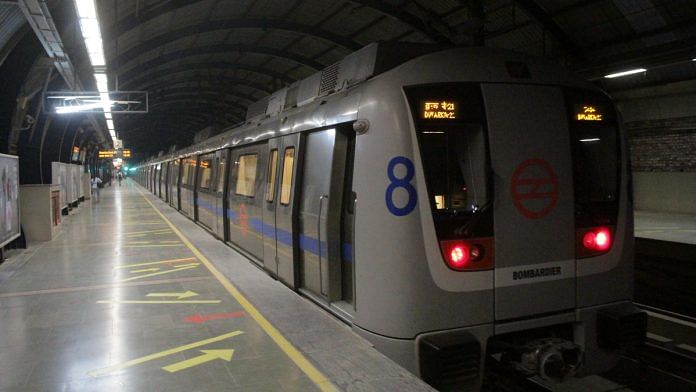New Delhi: As residents of the national capital region (NCR) wait for the day they’ll be able to ride their trusty Delhi Metro again, the trains are also performing drills to make sure they are well oiled when the Covid-19 lockdown lifts and it’s back to business.
The Delhi Metro Rail Corporation (DMRC) has been running empty trains across its 360-km network — dotted with 264 stations and 14 depots — to keep the system in check.
On all but two lines, Metro trains are being operated from each terminal station (where trains start and end) at least two times a day, with personnel working in shifts.
The DMRC shut down Metro services on 22 March, three days before the nationwide lockdown came into effect, as India rallied to check the spread of Covid-19.
DMRC executive director (corporate communications) Anuj Dayal told ThePrint that the drills are meant to ensure the system is “healthy and operating fine”.
Until 2 May, over 3,500 train trips had been made to keep the Metro system prepared to resume operations, said a DMRC official. When asked about the latest figures, DMRC officials claimed the data would only be available after the third phase of the lockdown ends.
Also Read: When Delhi Metro reopens, these are the guidelines CISF wants followed by commuters, staff
To keep it smooth
Introduced in 2002, the Delhi Metro has emerged as the public transport of choice for scores of Delhiites, with lakhs using its vast network daily to get across the expanse that is the NCR.
During the drills, personnel of the Central Industrial Security Force (CISF), which is responsible for the Delhi Metro’s security operations, secure the empty premises of stations and also screen the DMRC staff and officials who visit for maintenance and sanitation activities. They monitor the stations through physical patrols and CCTV cameras.
On each line barring the Grey Line and Airport Express, two trains are run from each terminal station daily, in the morning and evening. The aforementioned DMRC official said drills for the Grey Line and Airport Express are only performed every sixth day, in the morning hours.
To keep Metro trains glitch-free, smooth operations have to be ensured at a series of levels — signalling, condition of tracks, traction, and telecommunication, among others.
The drills focus on these areas, with staff also deputed at the operation control centres. However, instead of the 12-13 people deployed at the centres under normal circumstances, the exercise involves three persons at a time to maintain social-distancing norms, said Dayal.
The DMRC is also carrying out HVAC (heating, ventilation, and air conditioning) exercises for over 2,000 train coaches. For the first time ever, a senior official said, 1,200 coaches have been cleaned with special chemicals.
“We are trying to effectively use this time of the lockdown as usually one is not able to carry out these exercises when trains run up to 20 hours a day,” said the official, adding that passengers might return to better air-conditioning in the Metro.
While there is no clarity yet on when exactly the DMRC will resume operations, the CISF has already devised guidelines on safety measures and social-distancing norms that will have to be followed.
The guidelines involve mandatory download of the Aarogya Setu app, the government portal that allows you to know of Covid cases in the vicinity, and controlled entry into stations in keeping with social-distancing guidelines.
As of Tuesday morning, Delhi had 7,639 Covid-19 cases and a total of 86 deaths.
Also Read: Delhi lesson for Mumbai Metro — 43,700 trees cut, but 36 lakh tonnes of carbon sucked out



